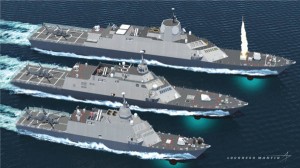 Back in early 2013, the Washington Post reported that China had acquired data and plans for several programs, including plans for the Littoral Combat Ships. If that is the case, what is a Navy to do when the “opposition” has all the blueprints?
Back in early 2013, the Washington Post reported that China had acquired data and plans for several programs, including plans for the Littoral Combat Ships. If that is the case, what is a Navy to do when the “opposition” has all the blueprints?
With cyber espionage becoming an increasingly appreciated risk, then there must be some nugget of strategy emerging in how to respond when the “opponent” is over-incentivized to acquire enough design material to derive significant insights.
 Do Ship Blueprints Actually Matter?
Do Ship Blueprints Actually Matter?
Of course they do.
Not only does the recipient get a literal “boat-load” of intellectual property (hundreds of millions of dollars) and, in something that is built to conform with American Bureau of Shipping Naval Vessel Rules (a great summary of NVR is here), the hacker gets the product of centuries of invaluable trial-and-error experience—all that work that has gone into complying with the rules, regulations and requirements that comprise naval shipbuilding design standards. It’s the type of intellectual property that helps a Navy that, until recently, was content to supply front-line ships with non-fire-proofed plywood bulkheads, to rather abruptly adopt standards that look an awful lot like they were ripped from the pages of the NVR (Naval Vessel Rules).
Depending upon the size of the loss, the hacker also might get insights into production strategy and the overall cost of the platform, an idea of the modifications/variations between ships and a glimpse at how the ship is evolving to meet modern threats or, simply, to user demands
Blueprints obviously matter on the battlefield, and, after careful study of basic non-classified hull, electrical and mechanical blueprints, a savvy opponent can tailor strategies, sensors–even munitions–to the platform, focusing on the platform’s unique vulnerabilities. Single-point vulnerabilities can be identified and targeted for exploitation, and the the potential for platform soft-kill increases.
Well, the first thing is to acknowledge the loss (“D’oh!”). The Navy’s corporate instinct, of course, is to keep the loss hidden, minimize the scope of the loss and then classify the loss of the Navy’s combatant blueprints to facilitate damage control. And you’ve gotta be sympathetic–Nobody wants to acknowledge that crucial Navy data has been virtually handed to a potential “competitor”.
But nothing could be more wrong than to keep news of such a loss secret for very long–First, once the plans for the Navy’s front-line combatants go out the door to a “competitor”, the matter becomes a policy issue. And good policy only happens when the policymakers have good, complete information. Second, failure to disclose the loss–and the extent of the loss–fails to encourage serious efforts to plug the gaps and work on prevention.
Either that, or the Navy’s going to just keep loosing their crown jewels–the intellectual edge that makes our fighting gear so good.
In terms of prevention, the Department of Defense must take real steps to make the loss of key platform IP carry serious fiscal consequences. First, rules protecting sensitive IP–heavy production blueprints–need to be inserted into the Federal Acquisition Regulations (I’m no DFARS jockey, but I think that’s in the process of being done…).
Second, the places where production blueprints are collected and archived need to be cut–limited to the Navy and the shipyard (or the shipyard’s design agent). I love classification societies, but the amount of data sucked up by classification societies (ABS, GL, DMV) are immense–and a large-scale data breach at these places means that the hacker has EVERYTHING needed to build a vessel. For those of you that don’t know, the Classification society pretty much touches, approves and then archives every. single. blueprint.
Some Classification Societies are more vulnerable than others. Classification society ABS (American Bureau of Shipping), which is busy making NVR into a world-wide standard, is becoming the de facto archive for naval shipbuilders everywhere…and that’s just too much of a risk. NVR–a rule set used by a wide range of international navies–makes ABS an obvious target for wholesale raiding, and, well, it’s just not wise to put all our eggs in such a potentially vulnerable basket. And anyway, having a middle-man in the enviable position of collecting fees from both the Navy and the shipbuilder can lead to problems. (Who in the shipbuilding business hasn’t tried to “game” their classification society? And how beholden is a classification society to safeguarding a Navy’s crown jewels if, say, the Navy decides to look elsewhere for the regulation of naval designs?)
Rather than rely on Classification Societies, NAVSEA needs to assume their role as the plans archivist and “Naval Vessel Rules” gatekeeper–and that’s going to require NAVSEA reconstitute lost expertise, and re-assume old responsibilities that have long been handed off to classification societies (I can hear my beloved warrior-accountants shrieking in indignation right now). Class societies are built to be information-sharing enterprises for civilian vessels, not quasi-international archives for classified (or just sensitive) information on naval ships.
At the end of the day, it’s the Navy that decides if their ships are fit for naval service. It’s not something that one can–or should have–privatized.
If a large number of detailed LCS plans have been lost, then the Navy seems to be taking a pretty logical step– slowing production of the legacy LCS designs and setting the stage for a big re-design (or to procure a new ship entirely).
With the loss of the LCS plans in mind, I would not be surprised if the two legacy LCS builders in the recent LCS Redesign RFI gave their designs a hard scrub, eliminating single-point failures and strengthening the overall resilience of their designs. I also wouldn’t be surprised if the builders took an opportunity to fundamentally rethink their internals, moving layouts around enough to shift key facilities to other places in the ship, rejiggering propulsion schemes or otherwise changing the game so their new LCS variant is less vulnerable to anybody exploiting stolen legacy LCS blueprints.
But the risk for the legacy LCS builders is that the vulnerabilities revealed in the stolen LCS blueprints are just too catastrophic to overcome with a modest re-design, and that an entirely new design offers greater inherent survivability. We shall see.
That said, loosing the plans for a ship with modular capabilities may be less catastrophic than loosing the plans for a traditional, fully-integrated vessel. That way, while an opponent might know that, say, a certain “Hull, Mechanical or Electrical” system lacks redundancy, it won’t know precisely what sensors and effectors are on board until too late. Put another way, I’d rather see the LCS plans get hacked before, say, a highly-optimized fit/form/function DDG-1000.
At some point, cyber vulnerabilities make it absolutely imperative to speed the refresh rate–platforms and gadgets need to be pushed from concept to the front lines BEFORE the opponent can pilfer the design material and, in turn, field a response.
Another thing to consider in this new cyber world is, frankly, modularity and numbers. Who cares if China knows how to stamp out Flensburg Ro-Ros or produce a simple car ferry catamaran when it is the stuff that was just put aboard that matters?
In the current environment, we must assume that no advanced naval design is safe. And we either need to focus on moving faster than the thieves or change our approach so the “opposition” gets less from raiding computers and, in addition, needs to put more resources into coming up with high tech solutions of their own making. And if that means buying a whole bunch of simple, hard-to-sink ro-ros and bolting VLS cells and other modular goodies in ’em, I’m all for it.





{ 1 comment… read it below or add one }
First rule – if you have any actual brains behind that intellectual property – it never touches any ‘internet’, trade secrets should be treated as actual secrets by the company that holds such. “Cyber” has been is now and will remain an artifact of crap information assurance practices. Now that we are in the ~ 20th generation of Moore’s Law computational horsepower is so cheap / ubiquitous that any analyst can/should have the computer they need at their worksite. Similarly mass storage has been following an exponential curve for storage per dollar expended so no valid excuses really exist for ‘clouds’ for either storage or processing. Realistically the IT oversight personnel attempting to ‘standardize’ the organization can be eliminated entirely as the worst wastes of buying ‘too much’ computer processing and storage would be a tiny fraction of the IT personnel budget.
As a corollary to the ‘problem’ of China supposedly having pilfered ‘trade secrets’; what to receiving nations worry about when they get retired USN vessels (and we really have all the blueprints and test data). Ask Taiwan and others about how that feels…